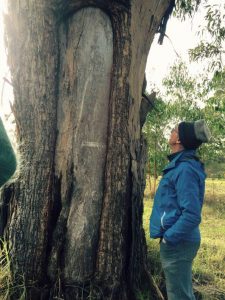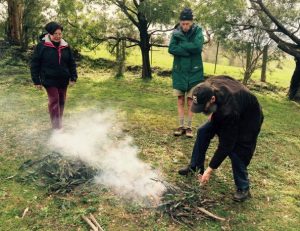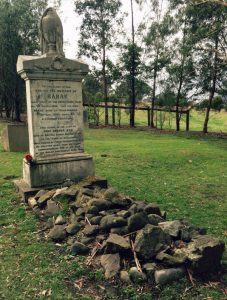On 3rd August, five folk from the U3A Walkers group travelled out to Healesville to walk on some of the land that is known as Coranderrk and to participate in one of a series of events conducted by the Wurundjeri Land Council (WLC) to mark their annual Wurundjeri Week celebration.
We were met at the Coranderrk Cemetery by Elder Allan Wandin who welcomed us to his country. He conducted a smoking ceremony and explained how visitors were offered a plate of foods which showed what they could eat on their land. He also gave us a passport of a manna gum leaf.
Allan spoke movingly of the difficulty he had had in recovering the history of his people. Most records were discovered in the journals written by the early Scottish and Irish settlers who had more in common with the aboriginal people than with the English aristocracy. There is a now a dictionary of the language but no one speaks it in every day conversation.
As we trudged around in wet and freezing weather Bunjil, the wedged-tail eagle, circled over the beautiful hills, reminding us of ancient stories and a remarkable people.
We were fascinated by our tour of the cemetery, which held the remains of four hundred bodies. Most of the graves were unmarked, but the names of the deceased were listed on a board showing their tribal association and including several which were listed merely as “baby XYZ”. Holding pride of place was the tombstone of Barak, the great aboriginal leader who was influential in establishing a success-ful farm and many industries on Coranderrk.
Allan also discussed WLC plans to restore the reserve near Heales-ville (off Barak Road), the area where over 400 aborigines had been relocat-ed in the 1860s. They aim, by their efforts, to reflect the work of the dis-possessed people who lived there and to create an historical site; a place for all to visit, to remember and to enjoy.
The Wurundjeri people have al-ready removed a massive amount of blackberries, some over three metres tall, as well as many other weeds and they have replaced them with many original species of bushes and trees. A walking path will wind through the ar-ea to show off the “before” landscape.
The army building and gardens on another section will be returned to their previous state, as will the farm, which they propose to re-establish as a working venture.
Further study on the area and its indigenous peoples is available in the remarkable books that Mick Woiwood has written or online.
Coranderrk, a National Heritage Site, is well worth a visit. It was a government reserve for Australian Aborigines in the state of Victoria between 1863 and 1924. It is locatated 50km north-east of Melbourne.




